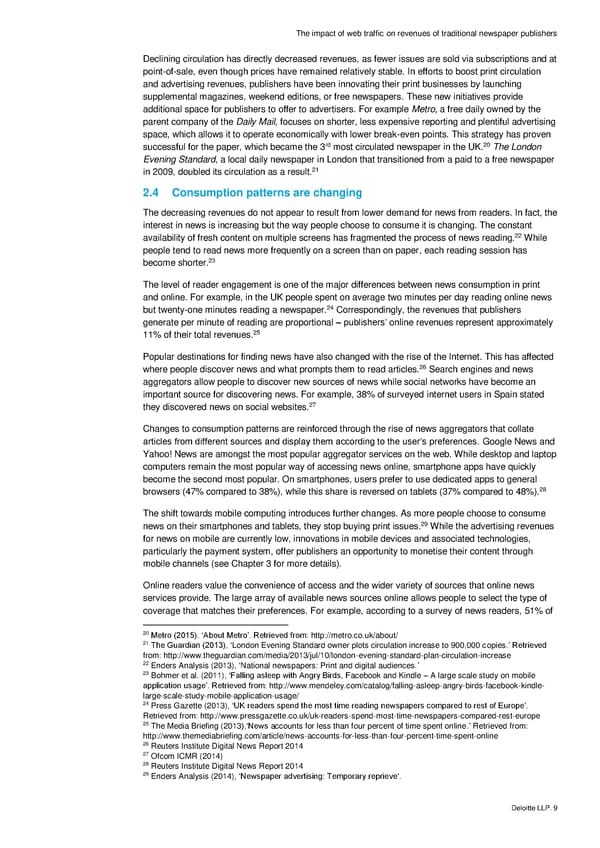The impact of web traffic on revenues of traditional newspaper publishers Declining circulation has directly decreased revenues, as fewer issues are sold via subscriptions and at point-of-sale, even though prices have remained relatively stable. In efforts to boost print circulation and advertising revenues, publishers have been innovating their print businesses by launching supplemental magazines, weekend editions, or free newspapers. These new initiatives provide additional space for publishers to offer to advertisers. For example Metro, a free daily owned by the parent company of the Daily Mail, focuses on shorter, less expensive reporting and plentiful advertising space, which allows it to operate economically with lower break-even points. This strategy has proven rd 20 successful for the paper, which became the 3 most circulated newspaper in the UK. The London Evening Standard, a local daily newspaper in London that transitioned from a paid to a free newspaper 21 in 2009, doubled its circulation as a result. 2.4 Consumption patterns are changing The decreasing revenues do not appear to result from lower demand for news from readers. In fact, the interest in news is increasing but the way people choose to consume it is changing. The constant availability of fresh content on multiple screens has fragmented the process of news reading.22 While people tend to read news more frequently on a screen than on paper, each reading session has 23 become shorter. The level of reader engagement is one of the major differences between news consumption in print and online. For example, in the UK people spent on average two minutes per day reading online news 24 but twenty-one minutes reading a newspaper. Correspondingly, the revenues that publishers generate per minute of reading are proportional – publishers’ online revenues represent approximately 11% of their total revenues.25 Popular destinations for finding news have also changed with the rise of the Internet. This has affected 26 where people discover news and what prompts them to read articles. Search engines and news aggregators allow people to discover new sources of news while social networks have become an important source for discovering news. For example, 38% of surveyed internet users in Spain stated 27 they discovered news on social websites. Changes to consumption patterns are reinforced through the rise of news aggregators that collate articles from different sources and display them according to the user’s preferences. Google News and Yahoo! News are amongst the most popular aggregator services on the web. While desktop and laptop computers remain the most popular way of accessing news online, smartphone apps have quickly become the second most popular. On smartphones, users prefer to use dedicated apps to general 28 browsers (47% compared to 38%), while this share is reversed on tablets (37% compared to 48%). The shift towards mobile computing introduces further changes. As more people choose to consume 29 news on their smartphones and tablets, they stop buying print issues. While the advertising revenues for news on mobile are currently low, innovations in mobile devices and associated technologies, particularly the payment system, offer publishers an opportunity to monetise their content through mobile channels (see Chapter 3 for more details). Online readers value the convenience of access and the wider variety of sources that online news services provide. The large array of available news sources online allows people to select the type of coverage that matches their preferences. For example, according to a survey of news readers, 51% of 20 Metro (2015). ‘About Metro’. Retrieved from: http://metro.co.uk/about/ 21 The Guardian (2013), ‘London Evening Standard owner plots circulation increase to 900,000 copies.’ Retrieved from: http://www.theguardian.com/media/2013/jul/10/london-evening-standard-plan-circulation-increase 22 Enders Analysis (2013), ‘National newspapers: Print and digital audiences.’ 23 Bohmer et al. (2011), ‘Falling asleep with Angry Birds, Facebook and Kindle – A large scale study on mobile application usage’. Retrieved from: http://www.mendeley.com/catalog/falling-asleep-angry-birds-facebook-kindle- large-scale-study-mobile-application-usage/ 24 Press Gazette (2013), ‘UK readers spend the most time reading newspapers compared to rest of Europe’. Retrieved from: http://www.pressgazette.co.uk/uk-readers-spend-most-time-newspapers-compared-rest-europe 25 The Media Briefing (2013),‘News accounts for less than four percent of time spent online.’ Retrieved from: http://www.themediabriefing.com/article/news-accounts-for-less-than-four-percent-time-spent-online 26 Reuters Institute Digital News Report 2014 27 Ofcom ICMR (2014) 28 Reuters Institute Digital News Report 2014 29 Enders Analysis (2014), ‘Newspaper advertising: Temporary reprieve‘. Deloitte LLP. 9
 The impact of web traffic on revenues of traditional newspaper publishers Page 14 Page 16
The impact of web traffic on revenues of traditional newspaper publishers Page 14 Page 16